* Banks *
A bank is wanted much in this town. The distance to Newton or Totnes being eight miles is most inconvenient.
Western Times 1 June 1850 p7 col4
In 1774 George III issued a proclamation to the effect that 'diminished' gold coinage was to be collected and exchanged.
Richard Eales and John Dolbeare were the people in Ashburton authorized to perform this task.
London Gazette Issue 11478 26 July 1774, p1
*******
Reminiscences of John Hele, of Alphington, Devon, John Hele, Exeter, 1870, piii
*Actually 1810?
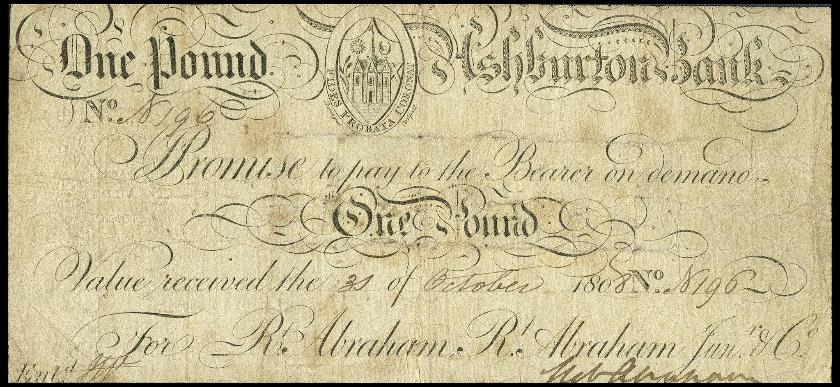
Many thanks to Jeremy Parker for this image
In 1810 the
Exeter Flying Post posted a statement from the Ashburton Bank, which
told of 'unexpected and heavy demands'. Payments of cash and banknotes
were suspended, but the bank said that a statement would shortly be
produced showing all credits and debits, promising that this would show a
healthy balance.
Exeter Flying Post 6 September 1810 p1 col2
A Certificate of Bankruptcy to be awarded to Robert Abraham, Banker, Money-Scrivener, Dealer and Chapman
London Gazette Issue 16755 20 July 1813, p25
For a promissory note from the Ashburton Bank, see the Virtual museum 1800s section.
R Abraham is still being shown under Bankers for Ashburton two years later, 'draw on Esdaile and Co., Lombard-street'.
Crosby's Complete Pocket Gazetteer, London, 1815, p19
Sir, Having read, a few months ago...an excellent article on the subject of the vile paper currency of this country and the ruinous system kept up by the issues of notes from country banks, I am induced to lay before you a few facts...The runs on the local banks, in this part of the county, have been excessive...Within these last twelve years, and certainly within the space of thirty miles from this place, I recollect the failure of the following banks: a fact more serious in its consequences, I venture to affirm, cannot be paralleled in any country in the world. [A list of 13 banks follows, of which Robert Abraham's Ashburton Bank is one]'
Dividends
were paid out to creditors of the bank for several years. It was not
until 1835 that the Commissioners in a Commission of Bankruptcy met for a
final time (at the London Inn) to audit the accounts and make a final
dividend of the estate and effects. Any creditors who had not already
proved their claim were to come prepared to do so, or their claim would
be disallowed.
Western Times 1 August 1835, p1 col1
* ******* *
When John Winsor and his wife Susanna have a daughters baptized in June 1817 and October 1818, John is described as a banker.
Ashburton Baptisms 1813-1821 Devon FHS 2006
Parish register
Letitia Dorothea Cuming. Born in Ashburton in 1786*, she was the daughter of George Winsor and Letitia Luscombe of Totnes. It was Letitia's brother John Winsor who was part of the Ashburton Bank. She married Francis Brooking Cuming, a solicitor who entered banking and became a partner in Brown, Winsor and Cuming. However, Francis died in 1822, and his wife was left his share of the partnership.
Women who made Money, Women Partners in British Private Banks, 1752-1906, Margaret Dawes and Nesta Selwyn, Trafford publishing, 2010, p133
* George Winsor married Letitia Luscombe, 2nd January 1781. Letitia Dorothea Winser was baptised 21st Feb 1787, Ashburton, daughter of George and Letitia. Letitia Dorothea Winsor married Francis Cuming 1st March 1814
https://familysearch.org
'We regret to say that the Ashburton Bank, of Mssrs Brown, Winsor and Cuming, suspended payments yesterday evening (Thursday) after a tremendous run of several days (Devonshire Freeholder).'
Galignani's Messenger, Paris, 9 December 1825
'By a
letter from Ashburton, we find that the bank of Messrs Brown, Winsor and
Co. which recently stopped payment, will pay off their notes on the 2d
of January next; indeed their notes are now current among the tradesmen
of that place. In the present agitated state of public credit, we have
much pleasure in giving publicity to this information.'
Galignani's Messenger, December 16, 1825
In 1825 there was a run of several days on the bank of
Mssrs Brown, Winsor and Cuming. Rumours that the bank was suspending
payments were current in the morning, and were 'fully confirmed' in the
afternoon.
Devonshire Freeholder, reported in Palmer's Index to The Times, 6 December 1825, p2 col4
11 December 1858 'At Ashburton, aged 76, John Winsor esq., for many years one of the firm of the Ashburton Bank.
Gentleman's Magazine, London, 1858, p118
*******
In 1827 a house was sold in East Street - it had a walled garden, outhouses, courtlege and a stable. It was 'lately used as a bank and now occupied by Mr Terry'
Exeter and Plymouth Gazette 12 May 1827 p1 col4
This is possibly the same building which housed a large safe until the latter part of the 20th century - No 81 East Street.
Wendy Major remembered that a safe was in a house in the area of No. 81. Alan Lambourne was taken into No. 81 by the owner and shown where the safe had been. Many thanks to both Wendy and Alan.
And was possibly the building used by Robert Abraham, or Browne, Winsor and Cuming, or both.
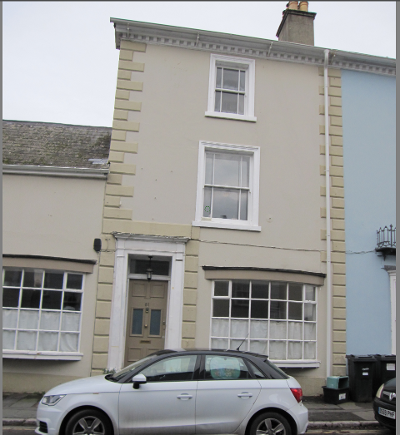
Watts, Whidbourne and Co.
The Capital and Counties Bank from 1891
1862 Messrs Watts, Whidborne and Moir opened a branch at Ashburton
Western Times 27 Dec 1862 p3 col 2
From Morris and Co's Commercial Directory and Gazetteer 1870: Watts, Whidbourne and Co., bankers, West Street (branch of ) draw on Williams, Deacon and Co. London. Manager - William Creber (see cheque in the 1880s section of the Virtual museum)
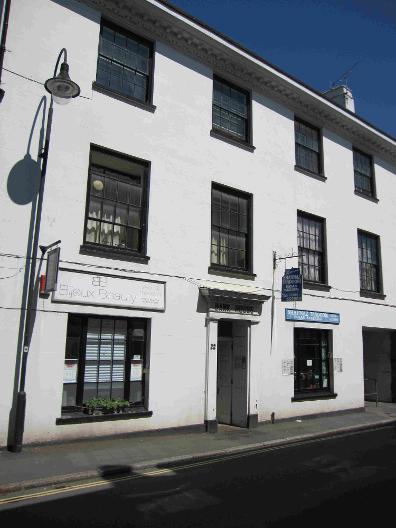
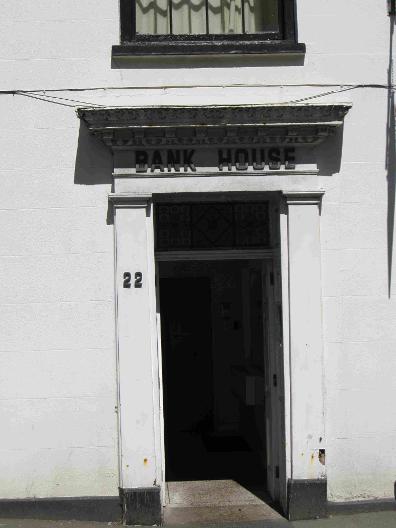
My own photograph 2016
1871 Census RG10, piece no. 2080, folio 57, p25
The London Gazette, part 4, October 1st 1875, p5237
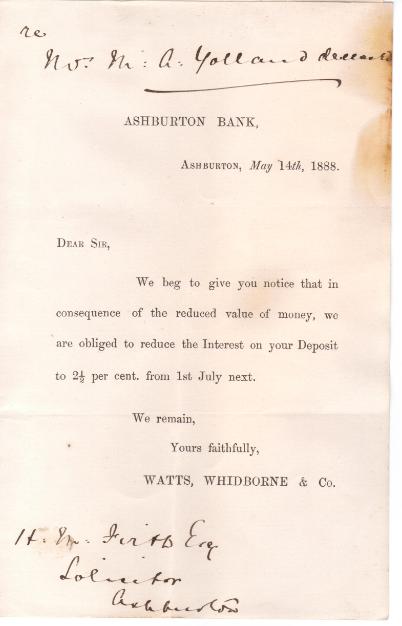
Exeter and Plymouth Gazette, 13 Feb 1891 p4 col 4 and Exeter and Plymouth Gazette, 16 Feb 1891 p5 col 4
Teignmouth Post, 20 February 1891, p5 col5
Briefly the National Provincial Bank in 1919? See Brixham Western Guardian below. In this year the National Provincial was established at what is now 19 East Street.
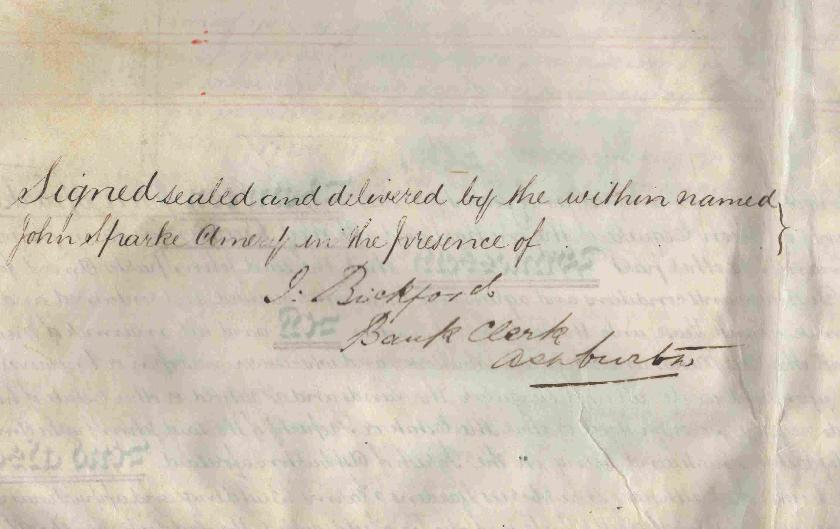
This may be John Bickford, who by the 1881 census was a 30 year old bank manager. When his mother died in July 1891 he was manager of the Capital and Counties Bank, Ashburton. 1881 census RG11, piece no. 2161, folio 55, p26
Western Times 21 July 1891, p2 col6
From my own collection
In 1892 Henry Stevens was clearing the area where the Duke's Head and an adjoining house had been. The Capital and Counties Bank was to occupy the site.
Western Times 17 March 1892 p4 col6
1893 The new premises of the Capital and Counties Bank were opened at the Bullring.
Exeter Flying Post 5 August 1893 p7 col1
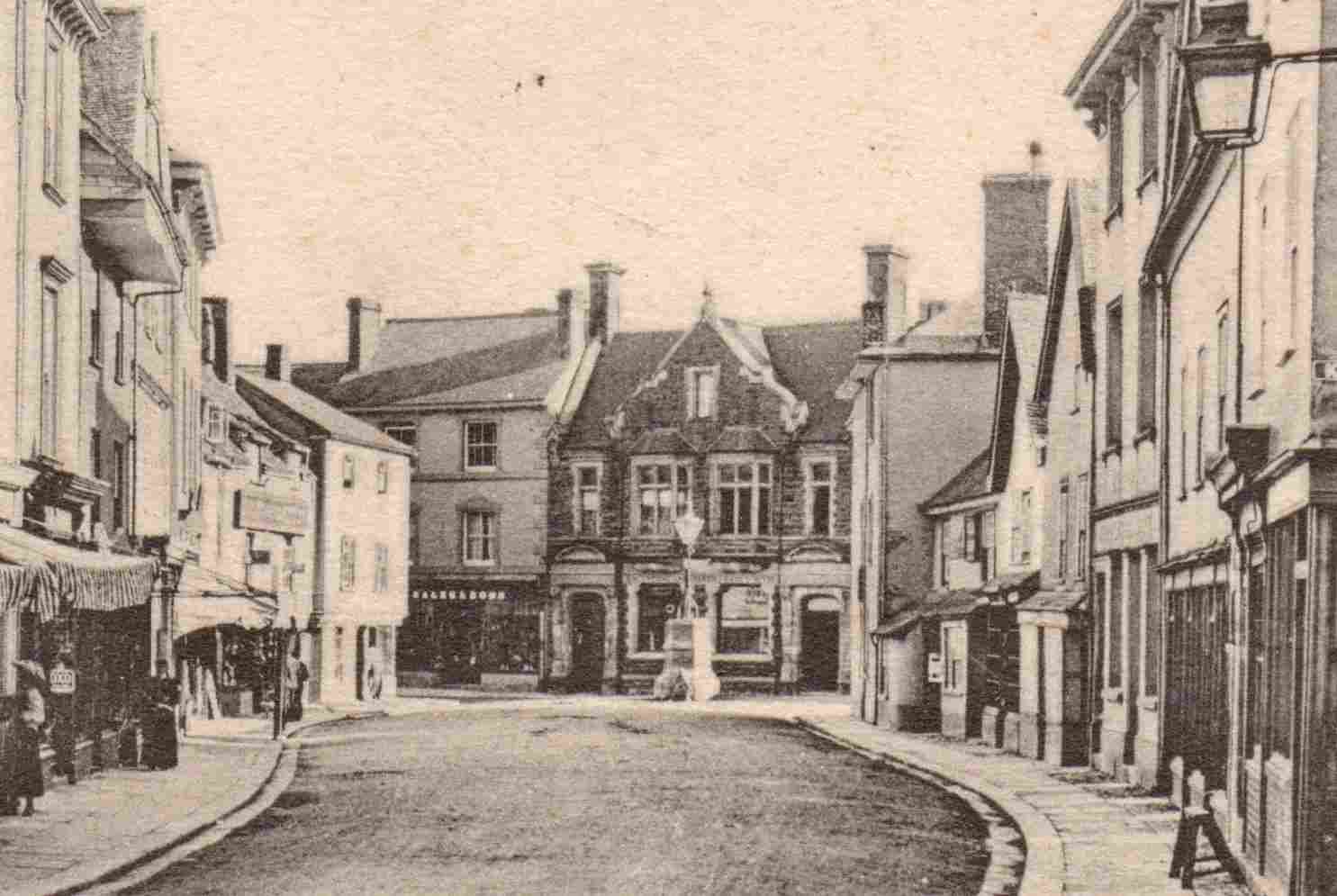
Above: Centre of picture ˄
The Capital and Counties Bank
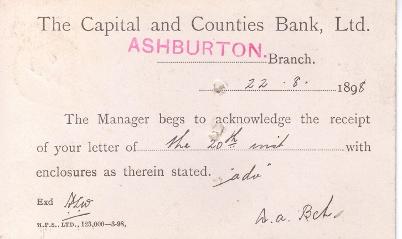
Edward Babington Lenton was the manager in 1902
Totnes Weekly Times 7 December 1901 p3 col4
Kelly's Directory of Devon 1902, p32
From Ashburton, Buckfastleigh, Brent and Ivybridge Almanac 1906:
Banks - Capital and Counties Bank, East St, manager - Mr W P Rendell
The Capital and Counties Bank, a dwelling house, was Walter Pollard Rendell's address on the 1911 electoral register.
England and Wales electoral registers 1910 - 1932, available through https://www.findmypast.co.uk
Watts, Whidborne and Co. 'was taken over by the Capital and Counties Bank in 1891, and the latter, in turn was absorbed by Lloyds Bank in 1918.'
Exeter and Plymouth Gazette, 2 August 1924, p4 col2
Lloyds Bank also bought the Devon and Cornwall Bank in 1906
Research by Nigel Brown. Many thanks to Nigel for his contributions to this page.
The Brixham Western Guardian advertised in 1919 that The National Provincial Union Bank of England had opened a branch at Ashburton. They said that this was at 3, West Street (later numbered as 2 East Street)
Brixham Western Guardian 1 May 1919, p1 cols 5,6
The Lloyds archives says that Lloyds sold the branch at 19 East Street to the National Provincial.
Research by Nigel Brown
2 East Street was Lloyds in the 1921 census (and remained so until closure in 2016).
Benjamin Balkwill was at Lloyds Bank at the time of the 1921 census, with his wife Elizabeth Kate and daughter Margaret Elizabeth. Aged 44, he was the manager.
Lavinia Lamason, brush manufacturer, was the next property along, which means that the Balkwills were at No. 3 West Street, also known as 2 East Street. The Balkwills had been at [19] East Street in 1911.**
1921 census RG15, piece no. 10435, schedule 63
**In 1911 John I Lamason and his wife Lavinia are at 1 West Street: John is a brushmaker.
1911 census RG14, piece no. 12725
1921 Mr B Balkwill, manager of Lloyds' Bank, was appointed treasurer of the Ashburton and Buckfastleigh Cottage Hospital.
Western Times 13 May 1921 p10 col1
Benjamin Balkwill's funeral was held at Ashburton after his death at Braunton in 1938. He had been manager of the local branch of Lloyds for nearly 20 years, succeeding Mr C J Jeffery in 1909, and leaving Ashburton in 1927.
Western Times 24 June 1938, p5 col5
Gloucester City Deeds holds a mortgage with vacating receipt, dated between 1928 and 1932. Edith Eugenia Hellens of Kingsley Hotel, Ashburton, a widow, is one of those named. E Dyson, manager of Lloyds Bank, Ashburton, was one of the witnesses.
Ref D3117/3239, Gloucester City Deeds, Gloucestershire Archives. Catalogued on the National Archives website https://discovery.nationalarchives.gov.uk - accessed 14-10-2025
From Kelly's Directory of Devonshire 1935:
B W Blight, manager Lloyds Bank, East St. He had succeeded Mr. E Dyson as manager in 1934, and retired in 1950, after 44 years service.
Exeter and Plymouth Gazette 13 October 1950 p6 col3
His address on his attestation papers of 1915/16 is 60, Peverell Park Road, Plymouth, the address where he was living with his parents and brother in the 1911 census. Then 20 years old, his occupation was bank clerk.
https://www.freebmd.org.uk
British Army Service records 1914-20, available through https://search.findmypast.co.uk
1911 census RG14, piece no. 12295
When Bertram joined the 9th Battalion, Devonshire Regiment in 1916 the bank held his job open for him. In 1917 he was at Gheluvelt, near Ypres, and whilst trying to advance near a railway embankment he was hit by machine gun bullets. His nose was shot away, as was part of his face. He was assumed to be dead until a German soldier, pausing to examine the gold masonic ring he was wearing, realised that Bertram was alive. As a prisoner of war he was moved to Stettin near the Baltic Sea - on the way being bombed by the RAF whilst at Cologne Railway Station. He remained a prisoner of war until he was repatriated in 1918.
Treatment for his injuries then began, in Millbank and Wandsworths hospitals in London, and Everest in Teignmouth. For two years he was at Queens, Sidcup, a specialist facial surgery hospital, where he underwent 12 operations, with his face being rebuilt using procedures pioneered by Dr Harold Gillies. He was left with severe scarring, the Ministry of Pensions declaring that his wounds were equivalent to losing a limb.
Returning to his old job at the bank, Bertram was promoted to be manager of Ashburton in 1934.
He was a member of the Plymouth Hoe Masonic Lodge No. 4235, and was Master in 1930/31.
His story was featured in Faces of Conflict (2014) - an international study into the impact of World War 1 on art and facial reconstructive surgery.
Provincial Grand Lodge of Devonshire
From Richard Blight: 'Bertram William Brown Blight served in WWI with the 9th Devons and was badly injured at Gheluvelt. He was taken prisoner of war and was exchanged as part of a Red Cross prisoner exchange in 1918, before the end of the war. The scheme swapped prisoners who were so badly injured that they would not be able to fight again.
After a number of years in hospital he was given his old job back at the Capital and Counties Bank in his home town of Plymouth.
Before she was married, my grandmother was walking along Plymouth Hoe with a friend when her friend said, "Be careful, that is Bertram Blight coming towards us. I warn you he has been badly injured during the war."
My grandmother prepared herself for a shock, but she said, "Instead of a shock I saw his beautiful blue eyes, and fell in love with him." The net result of that meeting was 2 sons, 3 grandchildren, 6 great grandchildren and I can't remember how many great great grandchildren so far'.
After marrying, they moved to Totnes where my father and uncle were born, before moving to Ashburton, where he was the bank manager. They lived in the rooms above the bank.*'
Many thanks to Richard Blight ,Bertram Blight's grandson, for the above information.
* The 1939 register shows the family, with Bertram as a bank manager, living at 2 East St., the address of the Capital and Counties Bank
Right: On a Devon beach.
With many thanks to Richard Blight. Both pictures © the Blight family
http://findmypast.co.uk
http://www.gilliesarchives.org.uk
'I adored walking with him in the street, because everybody you knew respected him...'
Gerald Blight, speaking about his father on a BBC item http://www.bbc.co.uk/programmes/p02npp3v
Bertram Blight died, aged 61, in 1952, his death being registered in the Newton Abbot district. He is buried at Ashburton.
https://www.freebmd.org.uk
http://www.ashburtonarchive.org.uk
The Ashburton branch first opened in 1834 and lasted until 1844.
Research by Nigel Brown
Pigot and Co.'s National Commercial Directory of the whole of Scotland and the Isle of Man etc., London, 1837.
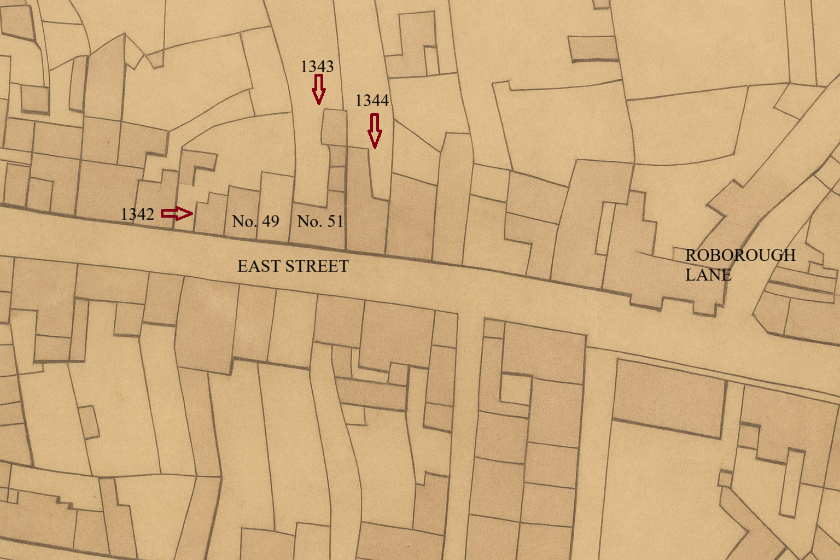
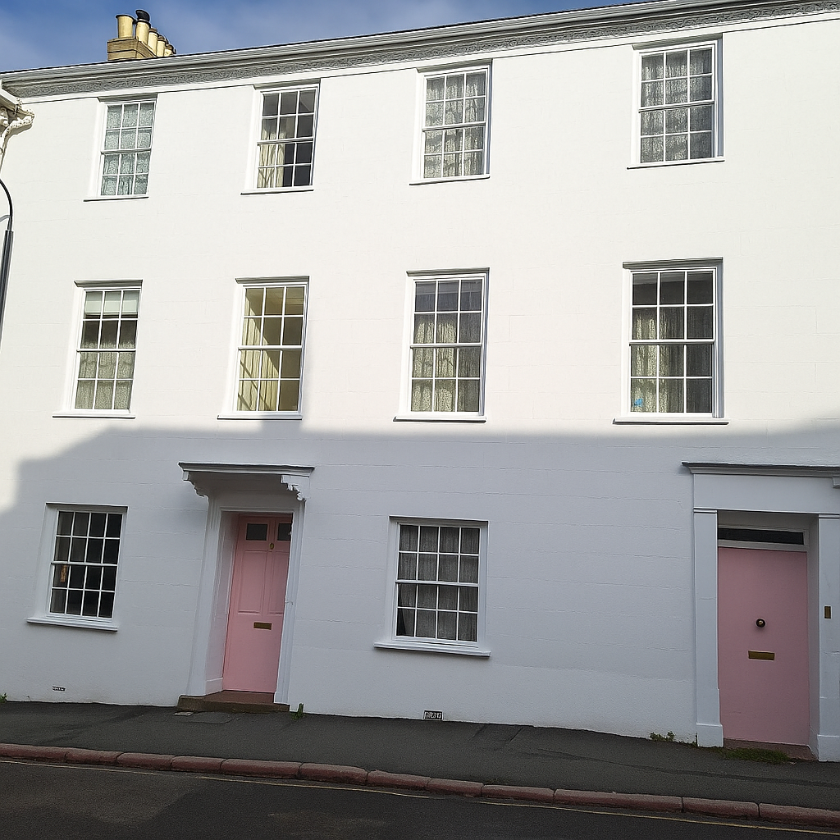
Robert Bean, aged about 40, was the manager of a bank in the 1841 census. He had not been born in Devon. On census night he was in East Street, between Cad Lane and Roborough Lane - ie on the north side of the street, where odd numbered properties now are.
1841 census HO107, piece 253, folio 19, p33
Western Times 13 May 1843 p3 col3
The Devon and Cornwall Bank was re-opened in 1889 until 1906 when the Devon and Cornwall Banking Company was bought by Lloyds Bank.
1891 census RG12, piece no. 1698, folio 49, p5
Western Times 21 April 1891 p7 col 3
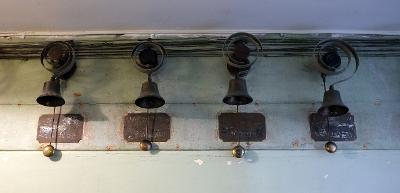
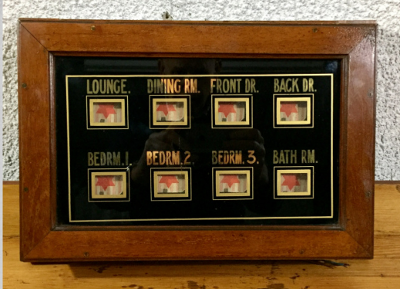
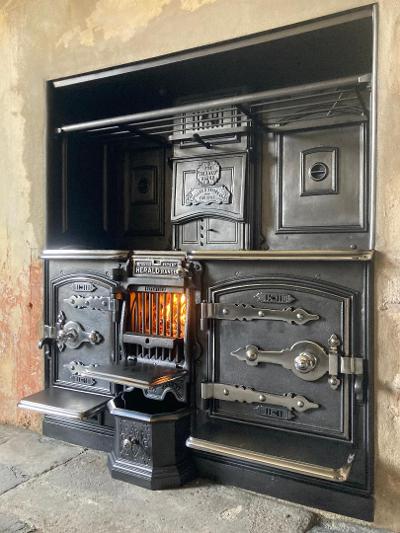
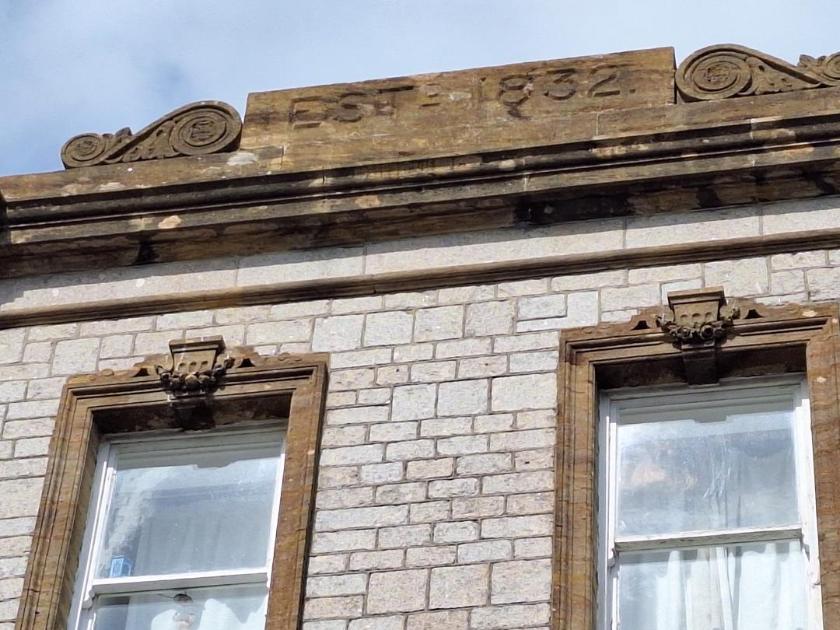
Below: A cheque drawn on the Devon and Cornwall Banking Company. James Woodley is paying H M Firth £1 in 1894.
From my own collection
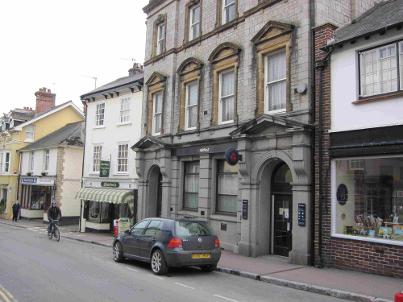
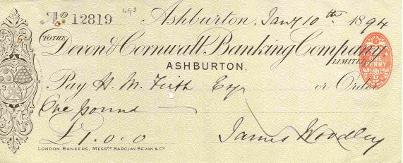
For another example of a cheque from this bank, see the Virtual Museum 1890s section.
1901 census RG13, Piece 2053, Folio 35, p2
Kelly's Directory for Devonshire 1902 p 32
From Ashburton, Buckfastleigh, Brent and Ivybridge Almanac 1906:
Devon and Cornwall Banking Co., East St, manager - Mr C J Jeffery
Lloyds Bank absorbed the Devon and Cornwall in 1906, and the bank then became known as Lloyds.
Research by Nigel Brown
Exeter and Plymouth Gazette, 2 February 1907, p6 col4
Benjamin Balkwill was at Lloyds Bank at the time, with his wife Elizabeth Kate and daughter Joan Hancock. His mother and sister were also in the household. Aged 34, Benjamin was the manager.
Next door was Alfred Ellis and family, at 21 East Street.
1911 census RG14, piece no. 12727, schedule 10.
In 1919 the premises at 19 East Street were sold to the National Provincial.
Research by Nigel Brown
52 year old Arthur Conroy, his wife Kathleen and three children were at Hazelwood, East Street, Ashburton, at the time of the 1921 census. Arthur was a banker, employed by the Nb P and U Bank of England.
1921 census RG15, piece no. 10435, schedule 32
1928 saw the funeral of Mr Arthur Conroy, 56, manager of the Ashburton branch of the National Provincial bank 'since established 8 years ago'
Amongst the mourners were: B W Blight (Lloyds Bank), N? H Shellard (Midland Bank) H W Snow (National Provincial Bank)
Western Times 20 July 1928 p13 col1
Hy Stanley Joyce, manager National Provincial, Bank Ho East St
Henry Stanley Joyce (1882-1961) wrote several books about fishing and the countryside, including 'By Field and Stream', which he published at Ashburton in 1934.
https://www.abebooks.co.uk
In 1911 he was a bank clerk, boarding at Folkestone; by the time of his marriage* in 1917 he was a cashier at the Dulverton branch of the National and Provincial.
*To Elizabeth Ruby Sanders
1911 census RG14, piece no 4639
North Devon Journal 15 November 1917 p4 col6
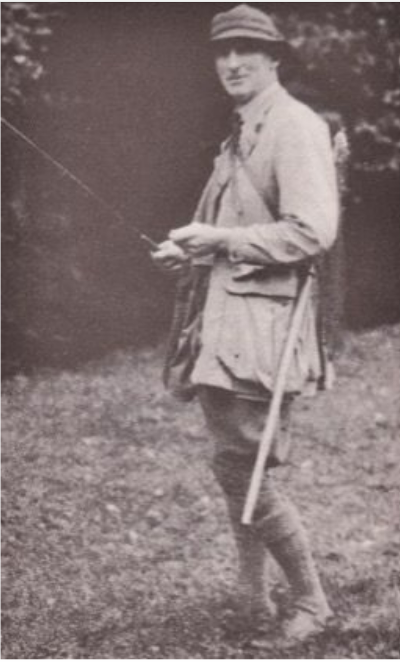
1939 register
From Mike McDonald: 'Uncle Harry loved the countryside, and became quite welknown in England as an angler and writer on rural topics. He wrote about six books and many articles for publications such as Field and Stream, which he illustrated himself with watercolours and pen-and-ink drawings...He wanted to be a farmer, but his mother thought that wasn't good enough for him, so he was made to join a bank against his will. He became a manager of the National Provincial in Barnstaple, and apparently was quite good at it, but never enjoyed the work. He was good at swimming, and at one time instructed the Portsmouth police in lifesaving. My mother told me he saved someone's life by jumping off a pier in Poole harbour and rescuing them.
At one point in his life he shared living quarters with Capt R F Scott, and was supposed to accompany him on his ill-fated 1910 expedition to the South Pole as a naturalist but was unable to go because of lack of space. A relative has a letter from Capt Scott to Uncle Harry explaining that he did not have room for him on the expedition, but inviting him to come on the next one, which of course never came about.'
Many thanks to Mike McDonald, and to Brian Joyce for permission to reproduce Mike's piece from:
http://www.wheathampstead.net/genealogy/joycefhdec.shtml - Accessed 17-12-2016
*******
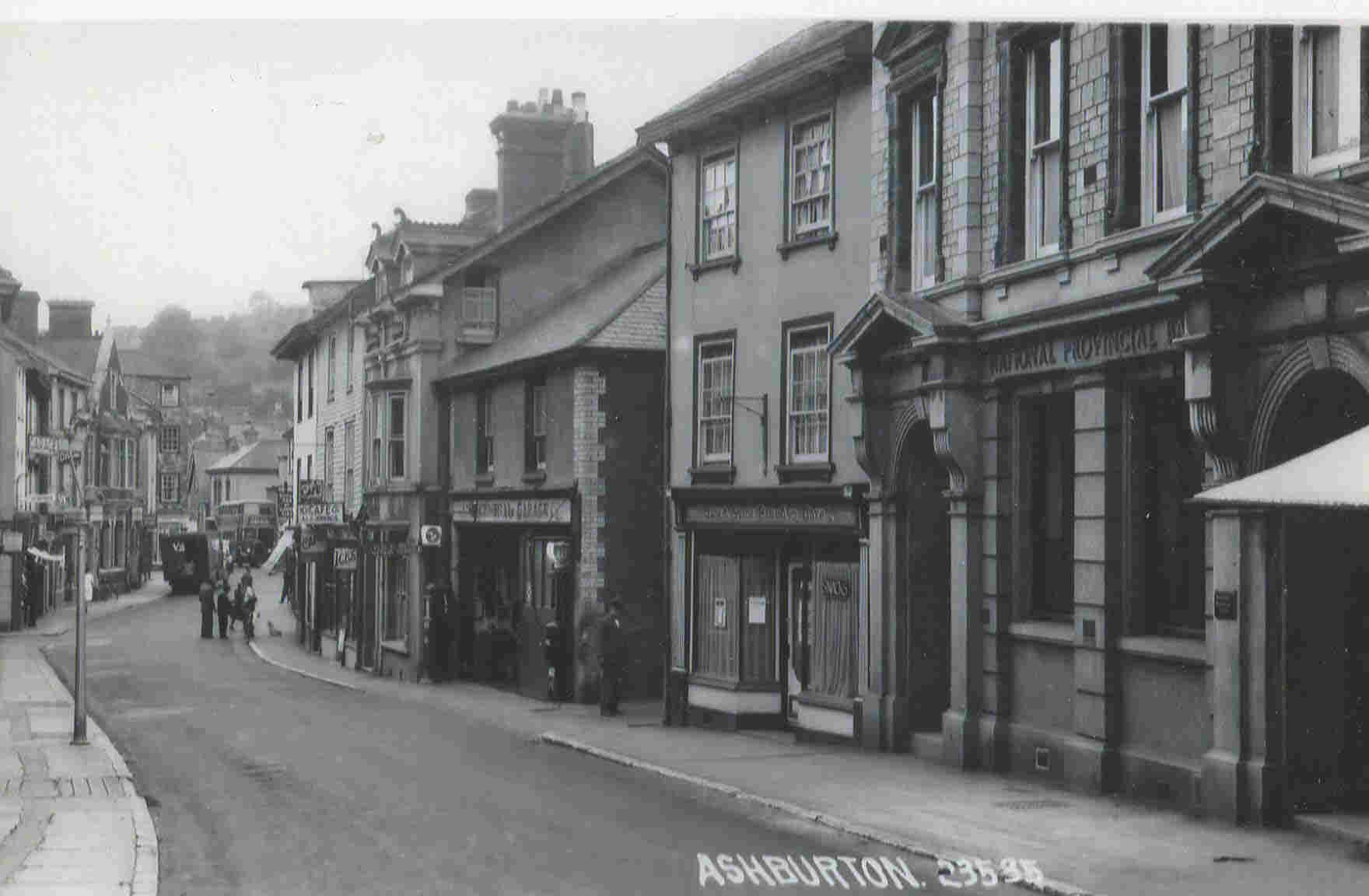
Above: The National Provincial Bank. Circa 1950s?
From my own collection
See the 1950s section of tne Virtual Museum for a stamping machine for the National Provincial.
The Ashburton branch of NatWest closed in 2015
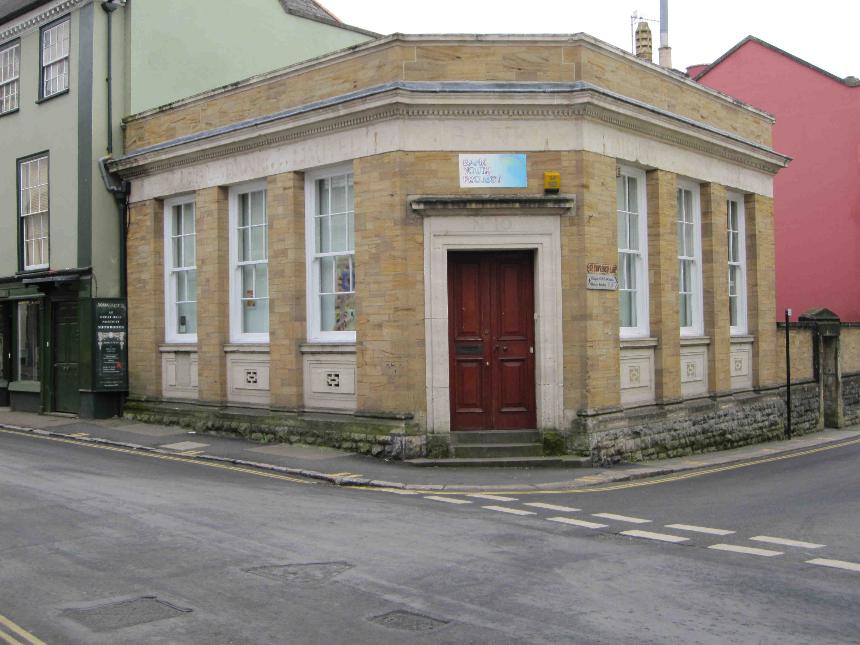
The Devon and Exeter Savings Bank
1878 Miss Susan Beck is the agent for the Devon and Exeter Savings Bank in East Street. It is open from 12 until 2 on Tuesdays, and 2 until 5 on Saturdays.
White's History, Gazetteer and Directory of Devon, 1878-79, p108
Devon and Exeter Savings Bank, East Street. Miss S Skinner, agent.
Kelly's Directory for Devonshire 1902 p 32
Brixham Western Guardian 29 January 1903, p6 col1
C H Baker, 8 West St, Savings Bank, Insurance Agency.
From the Guide to Ashburton - Ashburton Urban District Council, undated, but between 1930 and 1935:
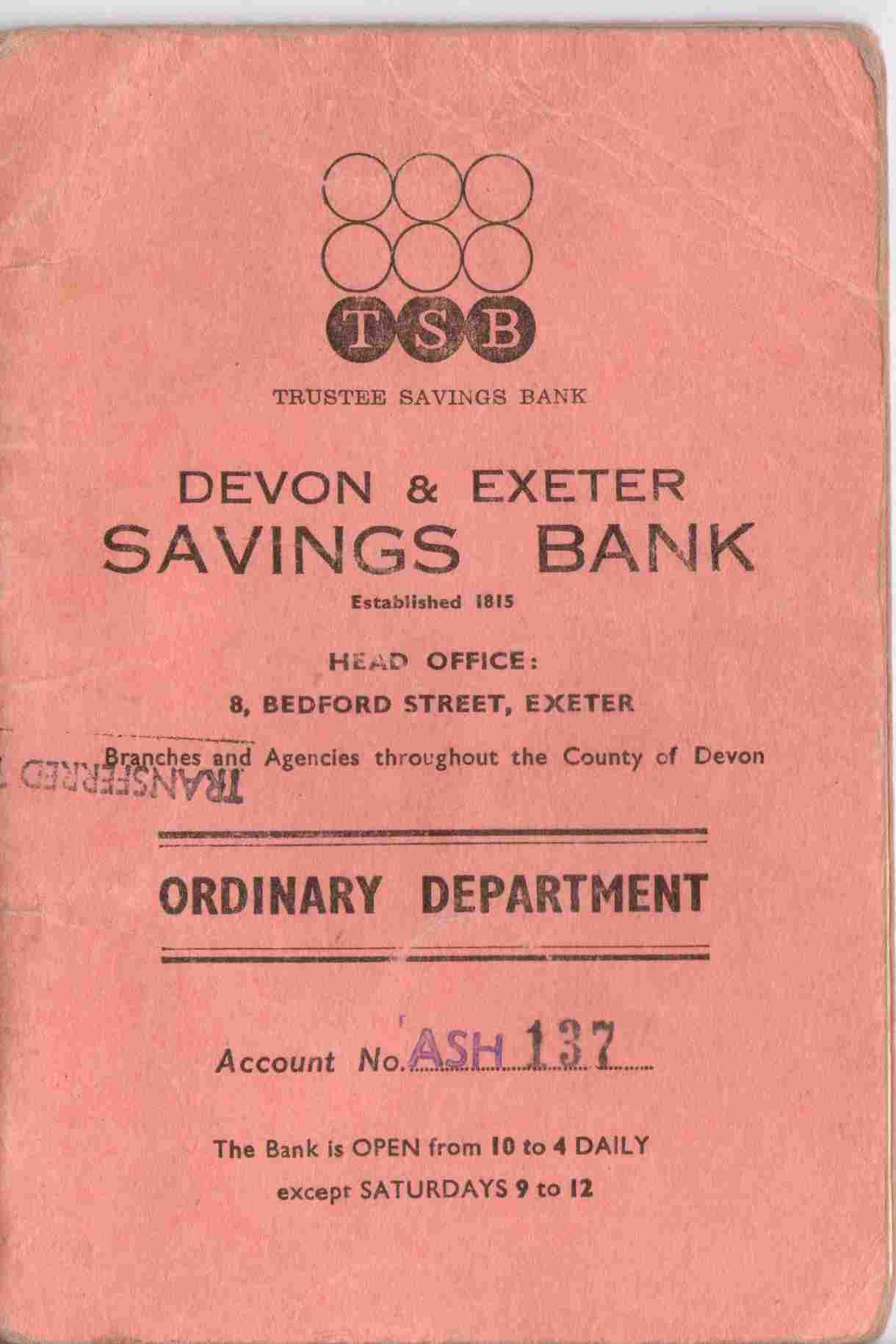
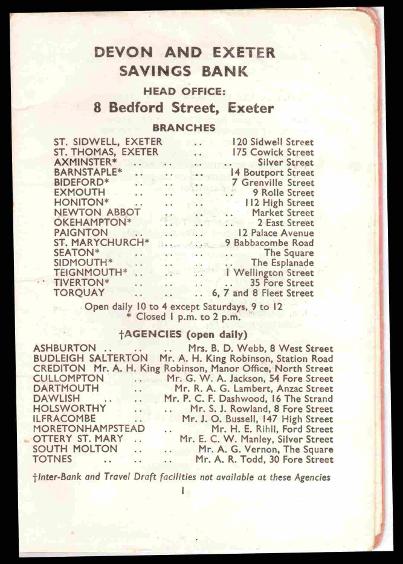
Above and above right: A Devon and Exeter Savings Bank book from the mid 1960s.
Mrs B D Webb is the manager, and the address of the bank is 8 West Street.
From my own collection.
*******